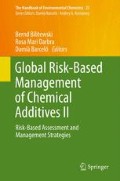Abstract
The leather sector is a traditional industry. This chapter will give an overview of the use of chemicals in the leather sector and identify different types and amounts of chemicals used in the different processes.
During recent years, there has been an increased focus on chemical substances including additives in many different articles such as shoes and gloves. In particular articles that come into contact with humans have been in focus. The concern being that humans and the environment will be exposed to hazardous substances from articles.
This chapter will give an overview of recent international trends and initiatives regarding chemicals in leather and articles containing leather. That includes the identification of chemicals in the produced leather that are common on restricted substance lists and present ongoing recent initiatives to control the impact from these chemicals including both legislative measures and initiatives from customers such as international brands or purchasing sectors and different eco-labels.
Access this chapter
Tax calculation will be finalised at checkout
Purchases are for personal use only
Abbreviations
- AOX:
-
Adsorbable organic halogen
- APE:
-
Alkylphenol ethoxylates
- BAT:
-
Best available techniques
- BBP:
-
Benzyl butyl phthalate
- BREF:
-
BAT reference document
- COD:
-
Chemical oxygen demand
- DBP:
-
Dibutyl phthalate
- DEHP:
-
Bis(2-ethylhexyl) phthalate
- DMF:
-
Dimethyl fumarate
- EPA:
-
Environmental Protection Agency
- EU:
-
European Union
- GADSL:
-
Global automotive declarable substance list
- IED:
-
Industrial Emissions Directive
- LWG:
-
Leather Working Group
- NGO:
-
Non-governmental organisation
- NP:
-
Nonylphenol
- NPE:
-
Nonylphenol ethoxylates
- PCP:
-
Pentachlorophenol
- PFOS:
-
Perfluorooctane sulfonates
- POP:
-
Persistent organic chemicals
- REACH:
-
Registration Evaluation, Authorisation and Restriction of Chemical Substances (European Community Regulation on chemicals and their safe use)
- RSL:
-
Restricted substance lists
- SCCP:
-
Short-chain chlorinated paraffins
- SSEI:
-
Swedish Shoe Environmental Initiative
- STWI:
-
Sweden Textile Water Initiative
- SVHC:
-
Substance of very high concern
- TCP:
-
Trichlorophenol
- VOCs:
-
Volatile organic compounds
References
Rydin S (2012) Risk management of chemicals in the leather sector: a case study from Sweden. In: Bilitewski B et al (eds) Global risk-based management of chemical additives I: Production, usage and environmental occurrence. The handbook of environmental chemistry, vol 18. pp 207–224
Rydin S (2012) Chemicals in leather. Presentation at risk-based management of chemicals and products in a circular economy at a global scale, Dresden, May 2012
European Commission (2012) Best available techniques (BAT) reference document for the tanning of hides and skins – final draft June 2012. See http://eippcb.jrc.es/reference/BREF/TAN_FD_06_2012.pdf. Accessed 15 July 2012
European Commission (2010) Directive 2010/75/EU of the European Parliament and of the Council of 24 November 2010 on industrial emissions (integrated pollution prevention and control)
European Commission (2006) Regulation No 1907/2006 of the European Parliament and of the Council of 18 December 2006 concerning the registration, evaluation, authorisation and restriction of chemicals (REACH)
United Nations Environmental Programme (2009) Stockholm convention on persistent organic pollutants (POPs) as amended in 2009
The Blaue Angel Eco-label. http://www.blauer-engel.de/en/index.php. Accessed 15 July 2012
European Commission, DG Environment Eco-label, see http://ec.europa.eu/environment/ecolabel/. Accessed 15 July 2012
Nordic eco-label website, see http://www.nordic-ecolabel.org/. Accessed 15 July 2012
Oeko-Tex 100 Eco-label website, see http://www.oeko-tex.com/oekotex100_PUBLIC/index.asp?cls=21. Accessed 15 July 2012
TÜV harmful Testing website, see http://www.tuv.com/en/usa/services_usa/product_testing/our_services/toxproof_1/toxproof.jsp. Accessed 15 July 2012
European Commission (2009) Regulation No 552/2009 of 22 June 2009 amending Regulation (EC) No 1907/2006 of the European Parliament and of the Council on the Registration, Evaluation, Authorisation and Restriction (REACH) as regards Annex XVII
Rydin S (2002) Investigation of the content of Cr(VI) and Cr(III) in Leather Products on the Danish Market. Survey of Chemical Substances in Consumer Products, Danish EPA
European Chemical Agency, see http://echa.europa.eu/en/web/guest/view-article/-/journal_content/a19f3846-4158-4351-8304-39de35c35f1b. Accessed 15 July 2012
European Commission (1998) Directive 98/8/EC of the European Parliament and of the Council of February 1998 concerning the placing of biocidal products on the market (Biocidal Products Directive)
Author information
Authors and Affiliations
Corresponding author
Editor information
Editors and Affiliations
Rights and permissions
Copyright information
© 2012 Springer-Verlag Berlin Heidelberg
About this chapter
Cite this chapter
Rydin, S. (2012). Chemicals in Leather: International Trends on Risk-Based Control and Management. In: Bilitewski, B., Darbra, R., Barceló, D. (eds) Global Risk-Based Management of Chemical Additives II. The Handbook of Environmental Chemistry, vol 23. Springer, Berlin, Heidelberg. https://doi.org/10.1007/698_2012_201
Download citation
DOI: https://doi.org/10.1007/698_2012_201
Published:
Publisher Name: Springer, Berlin, Heidelberg
Print ISBN: 978-3-642-34571-5
Online ISBN: 978-3-642-34572-2
eBook Packages: Earth and Environmental ScienceEarth and Environmental Science (R0)

